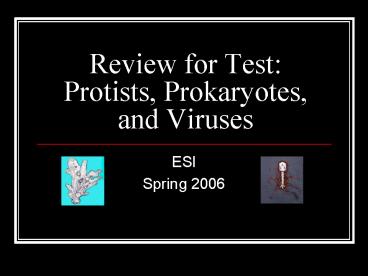Review for Test: Protists, Prokaryotes, and Viruses - PowerPoint PPT Presentation
1 / 22
Title:
Review for Test: Protists, Prokaryotes, and Viruses
Description:
Archaea are oldest & live in extreme conditions (no O2, boiling, freezing) ... immune system that are necessary for battling the pathogen (an agent that causes ... – PowerPoint PPT presentation
Number of Views:231
Avg rating:3.0/5.0
Title: Review for Test: Protists, Prokaryotes, and Viruses
1
Review for Test Protists, Prokaryotes, and
Viruses
- ESI
- Spring 2006
2
Protists The Basics
- Eukaryotic w/ nucleus!
- Algae, Euglenozoa, Protozoa
- Classified by movement
- Flagellate
- Ciliate
- Sarcodina
- Sporozoa
What organism is this?
3
Prokaryotes The Basics
- Appeared 3.8 billion years ago, no nuclei!
- Archaea are oldest live in extreme conditions
(no O2, boiling, freezing) - Cyanobacteria are photosynthetic
- Eubacteria can be parasites, decomposers, or
helpful to plants and animals!
4
Viruses The Basics
- Not alive! Need a host to reproduce
- Structure is simple
- Protein capsid
- Genetic material
- Resistant to antibiotics
- Affect all organisms
- Humans protect with interferons
HIV
5
Question 1
- How are Eukaryotes different from Prokaryotes?
- Eukaryotes have a nucleus, Prokayotes do not have
a nucleus. Instead, their genetic material is
exposed within their cytoplasm.
6
Prokaryotic Cell Structure
7
Eukaryotic Cell Structure
8
Question 2
- Why are viruses not considered living things?
- One of the criteria for living creatures is the
ability to reproduce. Viruses are unable to
reproduce without hijacking and destroying a
host cell. Also, viruses dont grow, develop, use
energy, or respond to their environments.
9
Viral Reproduction
http//www.lewiston.k12.id.us
10
Question 3
- Why are protozoa called animal-like protists?
Why are algae called plant-like protists? - Protozoa are not photosynthetic. Instead, they
have parts that allow them to move and collect
food in a way that is animal-like. Algae
contain chlorophyll and are therefore capable of
making their own food.
11
Algae vs. Protists
12
Question 4
- Why are we unable to classify euglenozoa as
either protozoa or algae? - They are a mix of both! They contain chlorophyll
(like algae and plants), yet they can move around
in different ways (like protozoa and animals). In
a way, they are hybrids!
13
Euglenozoa
14
Question 5
- What are the three basic shapes of Prokaryotes?
- Cocci, Bacilli, and Spirilla
15
Three Basic Shapes
Spirilla
Cocci
Bacilli
16
Question 6
- What are the four modes of movement of Protists
(Protozoa)? - Flagellate have flagella, Cilliate have
cilia, Sarcodina - pseudopodia, and Sporozoa no
movement
17
Four Modes of Movement
18
Question 7
- What is an interferon?
- Interferons are proteins that are made by our
bodies as an early defense against viruses. As
one cell is infected by a virus, it secretes this
substance to help make nearby cells more
resistant.
19
Question 8
- Why is HIV a particularly deadly disease?
- HIV infects the cells of the immune system that
are necessary for battling the pathogen (an agent
that causes disease). Now, other infections can
harm this person!
20
Question 9
- What is an endospore?
- An endospore is a protective covering that
prokaryotes produce when their environment gets
too dry. When the going gets tough, the tough get
endospores!
21
Endospore
22
Question 10
- What matter was used in your Petri dish to
provide nutrients for Eubacteria? Where does this
substance come from? - Agar! Agar comes from seaweed and is used to grow
bacteria and fungi.






























